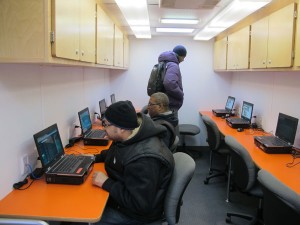- Account
- Commons Profile
- Activity
Collette Sosnowy
Alumna, Environmental Psychology; Project Manager, JustPublics@365
-
Collette Sosnowy changed their profile picture
-
Collette Sosnowy changed their profile picture
-
-
JustPublics@365
 As we bring our topic series on media skills to a close, we hope you’ve found these introductions to Twitter, blogging, writing Op-Eds, creating audio and podcasts, measuring your online impact, and conducting […]
As we bring our topic series on media skills to a close, we hope you’ve found these introductions to Twitter, blogging, writing Op-Eds, creating audio and podcasts, measuring your online impact, and conducting […] -
JustPublics@365
 Listening to peoples’ stories is a powerful way to understand how inequality affects people in their everyday lives. For example, gentrification in a low income neighborhood like East Harlem impacts a person’s ability to find affordable housing, education policies such as opening charter schools affect young people at local public schools, and lack of digital access limits economic opportunities.
Listening to peoples’ stories is a powerful way to understand how inequality affects people in their everyday lives. For example, gentrification in a low income neighborhood like East Harlem impacts a person’s ability to find affordable housing, education policies such as opening charter schools affect young people at local public schools, and lack of digital access limits economic opportunities.In this topic series on East Harlem, we have explored a number of social issues impacting the neighborhood and have featured the voices of local residents, activists, journalists and scholars.
Beginning with the aftermath of the tragic gas explosion in March, we highlighted the community conversation held at the CUNY School of Public Health that brought together volunteer first responders, city officials, activists, and researchers to talk about emergency response and plan for better preparedness in the future. The disaster, and the stories we gathered from participants at the event, highlighted a community that is unique and tightly-knit.
 However, this cohesiveness is threatened by changes brought on by disinvestment giving way to gentrification. East Harlem (aka El Barrio) is a primarily low-income, Latino neighborhood and has one of the highest concentrations of public housing in the city, yet its landscape is rapidly changing as higher-end chain stores open on 125th Street and luxury condos crowd out affordable housing.
However, this cohesiveness is threatened by changes brought on by disinvestment giving way to gentrification. East Harlem (aka El Barrio) is a primarily low-income, Latino neighborhood and has one of the highest concentrations of public housing in the city, yet its landscape is rapidly changing as higher-end chain stores open on 125th Street and luxury condos crowd out affordable housing.Gathering the perspectives of people who are directly affected, rather than interpret a situation for them, is vital to understanding these issues. East Harlem resident, activist, and filmmaker Andrew Padilla emphasizes this point in an article he wrote about a Fox News journalist who contacted him. The reporter, Soni Sangha, seemed determined to frame the story of gentrification in Latino neighborhoods like East Harlem as being “taken back” by wealthier Latinos returning to the area, implying that this form of “gente-fication” benefited the community rather than displaced residents. Padilla countered that perspective, sharing his experience interviewing people in the community and offered a more contextual explanation. Ultimately however, the article didn’t include the perspectives of East Harlem residents, which was a disservice to the community and readers alike.
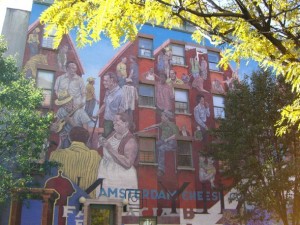 We highlighted two documentaries, “Whose Barrio?” by Ed Morales and Laura Rivera, and “El Barrio Tours: Gentrification in East Harlem” by Andrew Padilla, which explore the significant impact of gentrification on the neighborhood.
We highlighted two documentaries, “Whose Barrio?” by Ed Morales and Laura Rivera, and “El Barrio Tours: Gentrification in East Harlem” by Andrew Padilla, which explore the significant impact of gentrification on the neighborhood.We also profiled a number of scholars-activist and journalists working in the area, calling attention to these concerns, and working to address disparities.
Jeff Mays is a journalist who covers the neighborhood and spoke with us about how people have been impacted by the explosion. Even now, three months later, several of the nearly 100 families displaced by the disaster remain homeless and are having difficulty finding affordable housing in their community. Businesses are slowly recovering, but suffered great losses.
CUNY School of Public Health Professor Lynn Roberts addresses the intersection of race, class and gender and its influence on health disparities and models of community organizing for social justice.
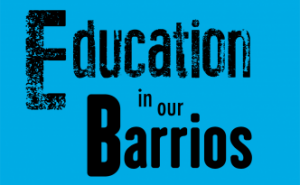 Educator-scholar-activist Edwin Mayorga recently worked with two young people from East Harlem to explore public education in the neighborhood and connected with community members using digital media to tell their stories.
Educator-scholar-activist Edwin Mayorga recently worked with two young people from East Harlem to explore public education in the neighborhood and connected with community members using digital media to tell their stories.And finally, we co-sponsored a symposium on drug policy reform, held at the New York Academy of Medicine. Many of the speakers focused on the intersections of race, poverty, and incarceration. Punitive drug laws and high rates of incarceration disproportionately impact low income, minority neighborhoods like East Harlem. CUNY Professor Harry Levine’s research reveals racial patterns in Marijuana arrests. As we wrote earlier, the data tell a story that whites use marijuana at higher rates, yet blacks and Latinos in neighborhoods like East Harlem are arrested for marijuana at much higher rates.
This collection of East Harlem stories exemplifies JustPublics@365’s approach to bring together scholars, activists and journalists to highlight social justice issues. By bringing together a diverse range of people with ties to East Harlem, we have offered a few of the many voices working to make the neighborhood a more just place for all its residents.
(Thanks to Edwin Mayorga and eastharlemmurals.com for images)
-
JustPublics@365
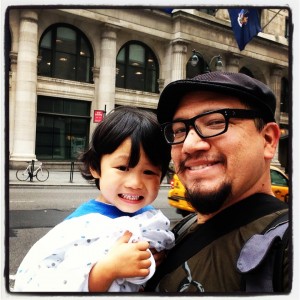 Edwin Mayorga describes himself as an educator-scholar-activist of color, as well as a parent, organizer, and doctoral candidate in Urban Education at the Graduate Center of the City University of New York. His recent work facilitating a digital participatory action research project explored how NYC education policies during the Bloomberg administration (2001-2013) have impacted “Latino core” communities like East Harlem. He and two youth co-researchers, Mariely Mena and Honory Peña, both East Harlem residents, designed and conducted the project, which they called Education in our Barrios.
Edwin Mayorga describes himself as an educator-scholar-activist of color, as well as a parent, organizer, and doctoral candidate in Urban Education at the Graduate Center of the City University of New York. His recent work facilitating a digital participatory action research project explored how NYC education policies during the Bloomberg administration (2001-2013) have impacted “Latino core” communities like East Harlem. He and two youth co-researchers, Mariely Mena and Honory Peña, both East Harlem residents, designed and conducted the project, which they called Education in our Barrios.The goal of the project was to gather the perspectives of parents, youth, community leaders, activists, educators, and educational leaders who have been connected to public education in East Halem/El Barrio. The team recorded video interviews, digitally recorded stories (using vojo.co), collected archival materials, census data, and policy documents. This data informed their critical analysis of educational and related social policies to document how several generations of people see and experience public education reform in East Harlem.
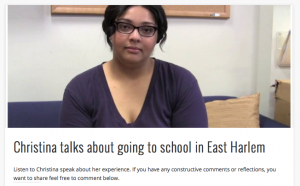 While the researchers wanted to use digital technologies as a way to connect to the community, the challenges they posed highlighted how the landscape of digital access, which is among other structural inequalities, impacts residents at both the individual level and larger social and economic level.
While the researchers wanted to use digital technologies as a way to connect to the community, the challenges they posed highlighted how the landscape of digital access, which is among other structural inequalities, impacts residents at both the individual level and larger social and economic level.In a recent talk at the CUNY Graduate Center, Edwin talked about some the challenges of engaging the community with digital media, and understanding how they make use of it. He said,
“The digital does introduce new ways of engaging the world but not everyone is quick to adopt those practices.”
One simple, yet significant obstacle to adopting digital networked technologies is access and affordability. In recent years, New York has become a more digital city, but for whom? City parks have become increasingly wi-fi accessible, but as Edwin pointed out, most of the park land in East Harlem is on Randall’s Island, which is both less accessible and becoming increasingly privatized. Free wi-fi spots in East Harlem and many other low-income residential neighborhoods, are few, as this map from the NYC Parks department illustrates.
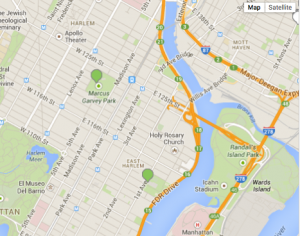 In an area like East Harlem, many may not be able to afford in-home broadband access, making free, publicly-available networks that much more important. In the neighborhood, the public library and McDonald’s are the primary spaces that have it. Despite being a vital community resource, the library suffers from disrepair and, like all NYC public libraries, decreased funding which cause them to shorten hours and limit services. A recent article on NY City Lens, an online news site, compared the recently renovated Washington Heights library and the Aguilar Library, which is located in East Harlem. The article highlights the great demand for access to library computers and the frustrations users experience from long waits, time limits, and slow access.
In an area like East Harlem, many may not be able to afford in-home broadband access, making free, publicly-available networks that much more important. In the neighborhood, the public library and McDonald’s are the primary spaces that have it. Despite being a vital community resource, the library suffers from disrepair and, like all NYC public libraries, decreased funding which cause them to shorten hours and limit services. A recent article on NY City Lens, an online news site, compared the recently renovated Washington Heights library and the Aguilar Library, which is located in East Harlem. The article highlights the great demand for access to library computers and the frustrations users experience from long waits, time limits, and slow access.Mayor Bill de Blasio called attention to the problem of uneven access as an issue of equality, social justice and economic mobility during his campaign and has said that the issue is a top priority for his administration. He has said that he will use the city’s regulatory, purchasing and franchising powers to pressure Verizon and other providers to increase access and lower costs to consumers.
In the meantime, the New York City Housing Authority has two vans equipped with eight computers and a printer, as well as high-speed wireless access that travel to parts of the city where connectivity is low. Hopefully, this innovative project, and other efforts to increase access and create a public network, will begin to balance out this inequality.
-
JustPublics@365
With the widespread use of social media, people often learn about emergencies via Twitter faster than they do on breaking television news or from official government news sources. In fact, these traditional news sources often get their information from social media and follow up to verify and report information.
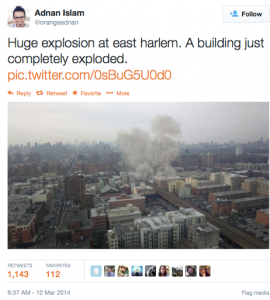 image source
image source
Obviously, the advantage of sharing information via social media is that the faster people have information, the faster they can respond. However, a disparate media landscape means that misinformation can also spread quickly, or that different sources may report different information, contributing to confusion.This was the experience for some in the wake of the gas explosion in East Harlem. While emergency responders and established organizations like the Red Cross adhered to their procedures, other groups like the Certified Emergency Response Team weren’t clear about their roles or where the most reliable information should come from. Participants in the April 26th community conversation held at the CUNY School of Public Health, these volunteers among them, emphasized the need for reliable, central communication channels during an emergency.
One interesting approach recently put into place in New Orleans makes use of personal health data to identify people with special needs and tailor responses to them. The New York Times recently reported on a pilot program that used Medicare data to target vulnerable individuals who may need extra help, such as people using breathing equipment. Officials from the program visited people in their homes to gauge the accuracy of the information they were able to gather from records and to get people’s reactions.
As journalist Sheri Fink wrote in the article,
“the program is just one of a growing number of public and corporate efforts to take health information far beyond the doctor’s office, offering the promise of better care but also raising concerns about patient privacy.”
While this program focused on visiting people in person, elsewhere, other digital and social media are being used to augment health care, such as text messages that alert parents that their children need to get vaccinations.

image source
But making use of personal health records raises privacy about using “big data” to reveal information people many not want shared. The pilot program conducted in New Orleans adhered to privacy guidelines and, as the article described, most people who were approached welcomed the help. However, the widespread use of digital media and the kind and amount of data we share, inadvertently or otherwise, has shaken up our ideas and expectations about privacy. The Health Information Portability and Accountability Act, more commonly referred to as HIPPA, and procedures of informed consent (i.e. all of those long forms you fill out at the doctor’s office) were designed to protect people’s personal health information from anyone other than themselves, their medical providers, and others with special permission, such as a family member. But those laws were drafted before digital media became so integrated in our everyday lives and before we thought about the potentials and pitfalls of vast stores of data.Could (or should) a program like the one in New Orleans work in East Harlem? How could it reach the whole community, especially those with special needs? Are there other models to follow? How could people’s privacy be protected? How could clear communication channels be designed given the many outlets for information?
-
JustPublics@365
In the wake of any disaster, emergency response typically includes the American Red Cross, whose recognizable logo signifies a first stop for help. Volunteers respond quickly to set up communication centers, […]
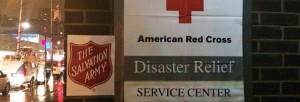
-
JustPublics@365
Numerous volunteer groups joined in the recovery efforts following the deadly gas explosion in East Harlem, and while the community’s most important needs were met, there was some confusion and disruptions in c […]

-
JustPublics@365
With churches large and small throughout the neighborhood, religious faith is a hallmark of the East Harlem community. It was only natural that ministers, pastors, and chaplains were prevalent in the aftermath of […]
-
JustPublics@365
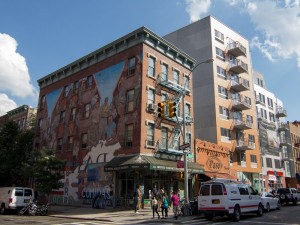 On Monday, NYC mayor Bill de Blasio released his ambitious 10-year, $41 billion affordable housing plan, which proposes creating 80,000 new units of affordable housing and preserving 120,000 more city-wide. It […]
On Monday, NYC mayor Bill de Blasio released his ambitious 10-year, $41 billion affordable housing plan, which proposes creating 80,000 new units of affordable housing and preserving 120,000 more city-wide. It […] -
JustPublics@365
As gentrification rolls across New York City like a tsunami, residents of lower-income neighborhoods like East Harlem are both concerned and conflicted about the changes occurring around them. This “Latino c […]

-
JustPublics@365
In his research, CUNY Professor Harry Levine documents the racial pattern in marijuana use and arrest rates. The data tell a story that whites use marijuana at higher rates, yet blacks and Latinos in neighborhoods like East Harlem are arrested for marijuana at much higher rates.
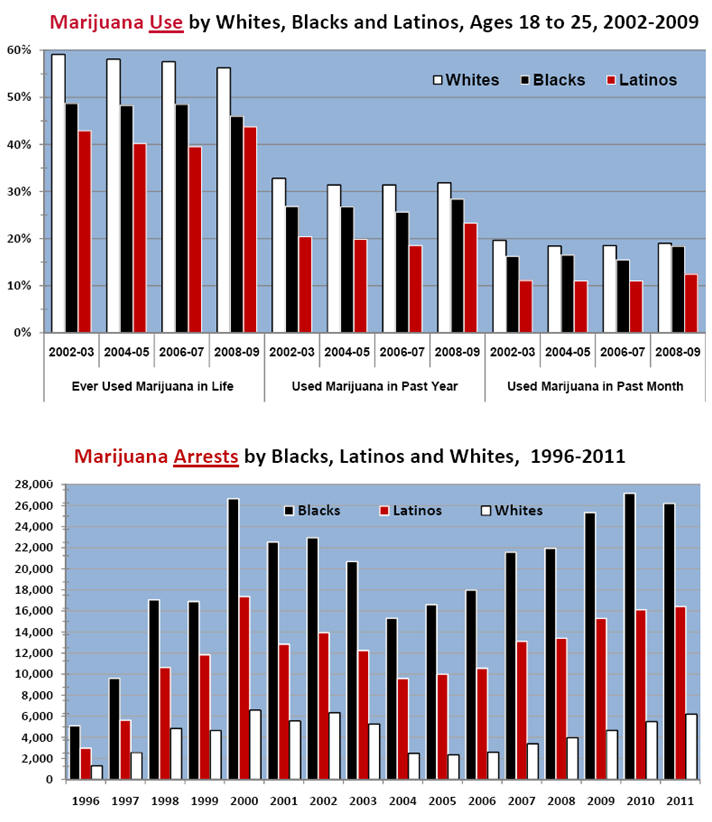
(Image source)
Marijuana policy is not a new issue to New York City nor to East Harlem.In 1939—on the heels of the national 1937 Marihuana Tax Act, which established federal marijuana prohibition—New York City Mayor Fiorella LaGuardia called upon The New York Academy of Medicine (NYAM) in East Harlem to produce a report about marijuana.
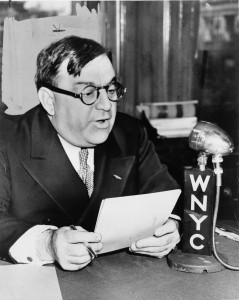 (Image source)
(Image source)
The La Guardia Committee Report: The Marihuana Problem in the City of New York was published in 1944 as one of the nation’s first systematic studies addressing many of the myths about marijuana, including: the alleged connection to “madness;” addictive potential; supposed role as a ‘gateway’ to other drug use; usage patterns; and potential relationship to crime and violence. The LaGuardia report concluded that “the sociological, psychological, and medical ills commonly attributed to marihuana have been found to be exaggerated.”To mark the 70th anniversary of the LaGuardia Report, The Drug Policy Alliance (DPA) and The New York Academy of Medicine (NYAM) are hosting a symposium to look back on the LaGuardia Report in order to inform a rich discussion of contemporary drug policy reform efforts, both nationally and in New York. The symposium brings together scholars, activists, journalists and elected officials from East Harlem to explore the historical context and the ongoing public debates and actions about marijuana and drug policy reform.
Marijuana & Drug Policy Reform
in New York—The LaGuardia Report at 70
May 1, 6-8 PM
May 2, 10 AM – 5 PM
A symposium hosted by
The New York Academy of Medicine and the Drug Policy Alliance
Program highlights includeThursday, May 1
6:00 PM — The John K. Lattimer Lecture: Richard Bonnie, University of Virginia.
Friday, May 2
10:00 AM — Melissa Mark-Viverito, Speaker, New York City Council
Panel Discussion: Drug Wars Past & Present.
Moderator: Paul Theerman, Ph.D., The New York Academy of Medicine
Jeffrion Aubrey, Speaker Pro Tempore, New York State Assembly
Jason Glenn, Ph.D., University of Texas Medical Branch, Galveston
Sam Roberts, Ph.D., Columbia University
Deborah Small, J.D., Executive Director, Break the Chains
Bobby Tolbert, Community Leader and Board Member, VOCAL-NY
1:00 PM — Panel Discussion: The Contemporary Research Agenda for Drug Use & AbuseModerator: Julie Netherland, Ph.D., Drug Policy Alliance
Helena Hansen, Ph.D., M.D., New York University
Julie Holland, M.D., psychiatrist and author
Amanda Reiman, Ph.D., Drug Policy Alliance, San Francisco
Maia Szalavitz, journalist
3:00 PM — Panel Discussion: New York Marijuana Policy Reform in 2014
Moderator: Kassandra Frederique, M.S.W., Drug Policy Alliance
Richard Gottfried, New York State Assembly, 75th District
Hakeem Jeffries, United States Congress, 8th District
Harry Levine, Ph.D., Queens University
Art Way, J.D., Drug Policy Alliance, Denver
4:30 PM — Closing Presentation: Dr. David T. Courtwright, University of North Florida5:00 PM – Final Remarks: gabriel sayegh, Drug Policy Alliance
* * *
This event is FREE but registration is required for both days. To register for this event (required), click here (Thursday evening lecture) and here (Friday). The symposium takes place at the New York Academy of Medicine, located at 1216 Fifth Avenue at 103rd Street. You can also follow along on the hashtag #LGA70.For more background on this important topic, see our “From Punishment to Public Health,” available as an eBook and a PDF.
-
JustPublics@365
Emergency responders are dedicated to doing work they don’t want people to know about, as one participant remarked during the recent East Harlem community conversation, held last Saturday at the CUNY School of […]
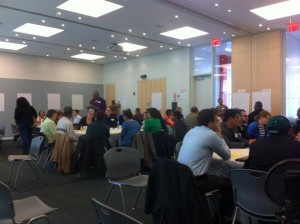
-
JustPublics@365
Jeff Mays is a reporter/producer for DNAInfo covering Harlem. He has written about East Harlem after the March 12th gas explosion and sat down with me to talk about how the community is recovering six weeks after […]
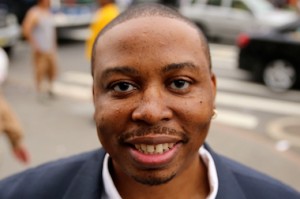
-
JustPublics@365
East Harlem is a neighborhood where the need for affordable housing is high, yet the availability of such housing is shrinking.
The March 12 gas explosion destroyed homes on the site and damaged several nearby. […]
-
Collette Sosnowy changed their profile picture
- Load More




